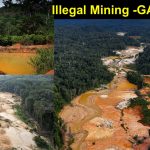Illegal mining (Galamsey) in Ghana is having serious and multifaceted negative effects on fisheries, from the rivers and estuaries inland all the way to coastal marine systems. Overall, galamsey undermines fisheries by polluting waters, destroying habitats, reducing fish reproduction and survival, and reducing incomes and food security. The effects are felt inland (in rivers) and along the coast due to river-sea connectivity. This issue needs attention not only from fisheries policy but also from mining, environment, health and community development sectors if the fisheries sector is to recover.
Water Pollution with Toxic Chemicals: Galamsey operations often use mercury and other toxic substances to extract gold. These chemicals leach into rivers, streams, and tributaries. These toxins accumulate in aquatic organisms (fish, invertebrates), causing both acute mortality and chronic health effects, which reduce fish health, reproduction, and survival.
Rivers such as Pra, Offin, Birim, Ankobra are repeatedly cited as severely polluted by galamsey activities, affecting both freshwater and marine fisheries downstream. In some areas, mercury levels in water bodies are reported to be many times above safe limits, leading to risk of contamination of aquatic life and human consumption. Spawning grounds (estuaries, mangrove fringes, deltas) are being damaged, eroded, or polluted, reducing recruitment of juvenile fish.
Food Security and Public Health Concerns: Because fish is a major source of protein in many Ghanaian diets, declines in fisheries affect food security, especially in coastal and riverine communities. Bioaccumulation of heavy metals (mercury especially) in fish poses health risks for consumers; kidney issues, neurological problems, developmental issues in children.
Other impacts of Galamsey on Fisheries in Ghana
o Increased Sedimentation and Turbidity: Illegal mining detaches soil and sediments (sand, silt, clay). This increases water turbidity (cloudiness) and high sediment loads block light penetration, reducing photosynthesis in aquatic plants and algae; this impairs the base of aquatic food chains. Sediment can clog fish gills, reduce oxygen levels, and smother fish eggs in spawning grounds.
o Destruction and Alteration of Fish Habitats: Mine pits, riverbank excavations, diversion of river courses, mining directly in rivers degrade or destroy aquatic habitat (e.g. shallow riverbeds, spawning grounds, estuaries). Also, mangroves, estuaries and the brackish water zones, which are crucial as breeding and nursery areas for many fish species, are damaged by the mining activities.
o Reduced Reproductive Success and Declining Fish Stocks: With spawning grounds destroyed or heavily polluted, many fish species have difficulty reproducing successfully. Juvenile fish may not survive. As fish populations decline, there is less recruitment of young fish, which worsens declines in catch levels over time.
o Altered Species Distribution and Behavior: Fish may move away from polluted or turbid waters, which pushes them into deeper or less optimal habitats. Some fish species more sensitive to pollution or habitat change may decline or disappear locally.
o Impact on Fishing Communities and Livelihoods: Fisherfolk report declines in catch quantity and quality. Less fish means less income. Some communities report catching “unhealthy” fish (contaminated, smaller sizes). Young people are increasingly leaving fishing for illegal mining since galamsey gives higher immediate return, weakening the traditional fish workforce.
o Economic and Market Effects: Decreased supply of fish leads to higher prices, making fish less affordable for many. Ancillary industries (fishmongers, processors, transporters) suffer as the volume and quality of fish declines.
By: Kwadwo Kyei Yamoah, Executive Director. HELP Foundation Africa. Convener: Fisheries Alliance / CSOs SDG 14 Platform








